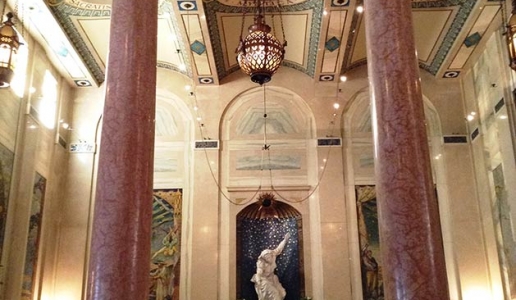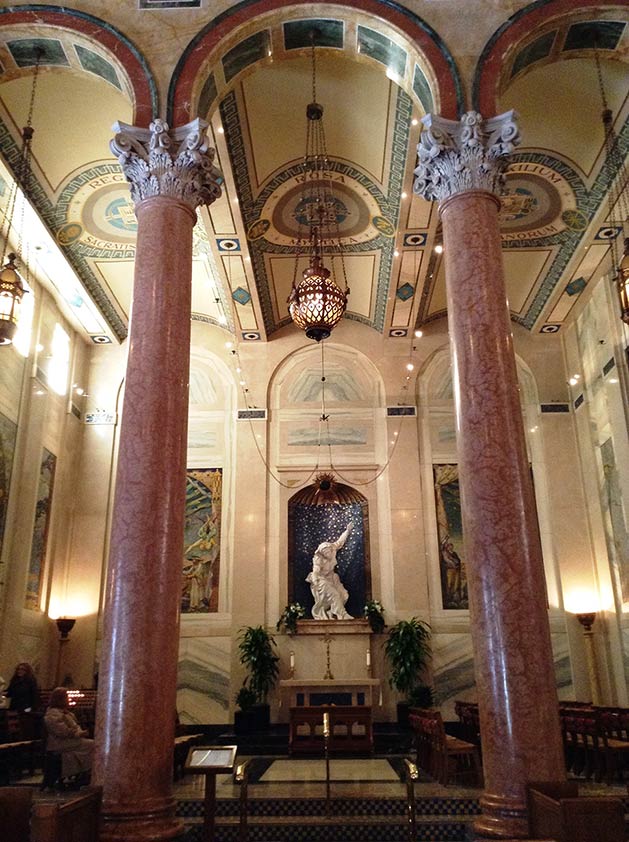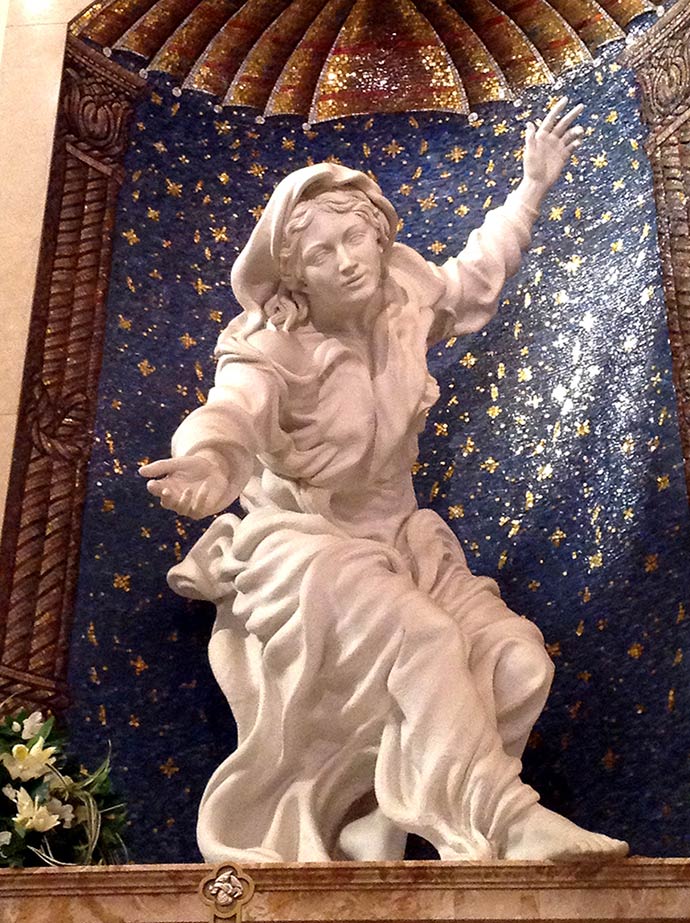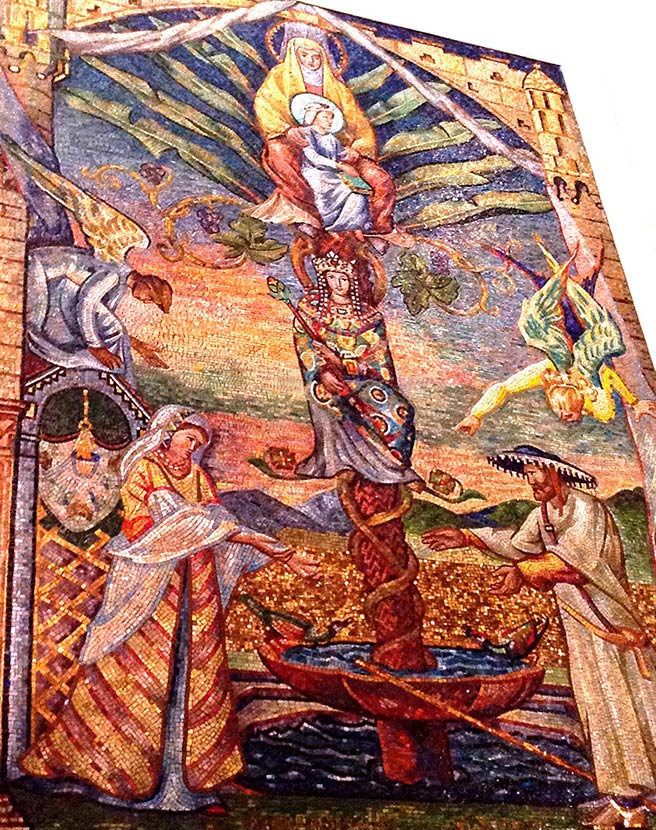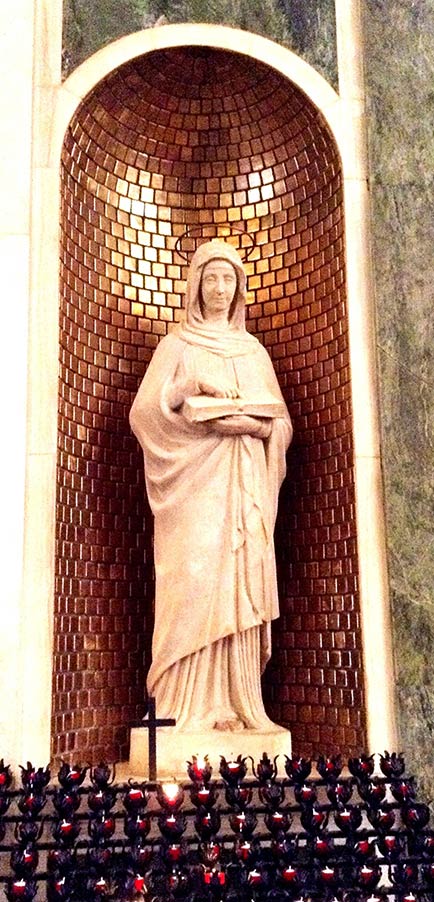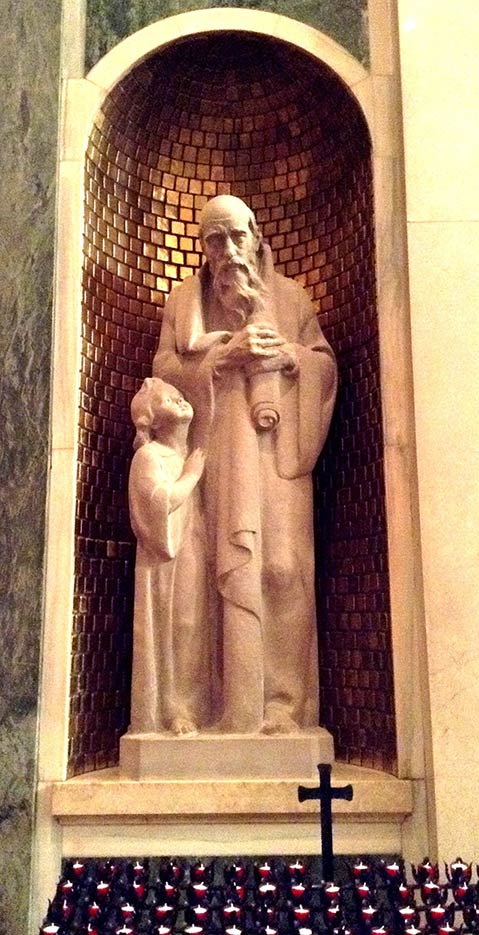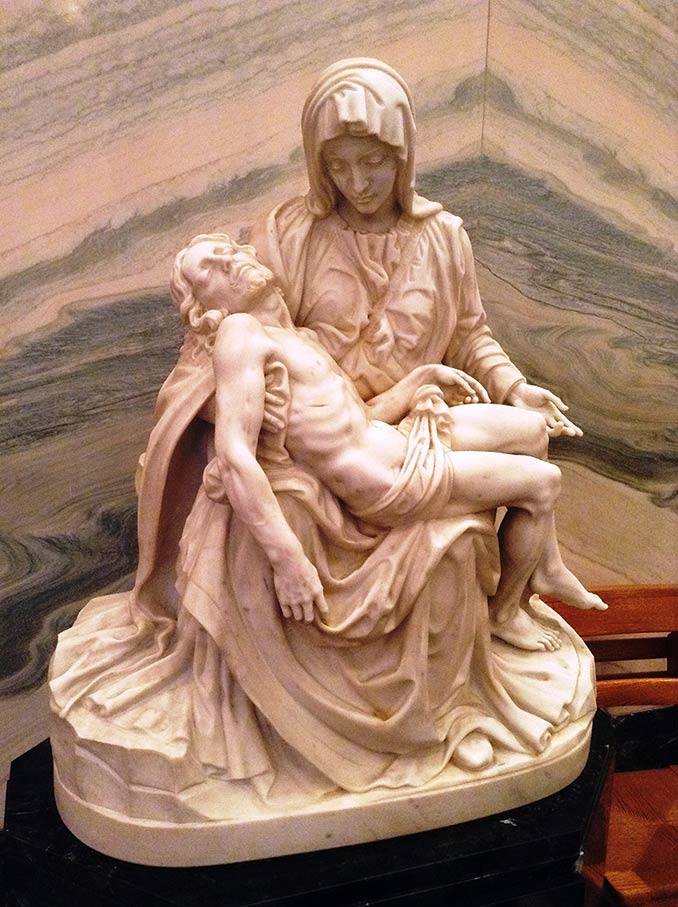Our Lady’s Chapel
Cathedral of St. Matthew the Apostle
Location: 1725 Rhode Island Ave NW, Washington, DC 20036
Metro: Red line to Farragut North or Dupont Circle.
by Allison Gliot
Ave Regina Caelorum:
Hail, Queen of Heaven,
Hail, Mistress of the Angels,
Hail, Root of Jesse,
Hail, the Gate through which the Light rose over the earth.
Rejoice, Virgin most renowned, and of unsurpassed beauty.
Farewell, Lady most comely,
Prevail upon Christ to pity us.
Our Lady’s Chapel (fig. 1) is located on the west side of the nave in the Cathedral of St. Matthew the Apostle, the seat of the Archbishop of Washington, D.C. Though the cornerstone for the church was laid in 1893 and Our Lady’s Chapel was blessed on November 29, 1936 (Philibert 60, 132), it has been repeatedly updated since construction on the cathedral first began, with a new sculpture of Mary added in 1984 to replace the previous one that had been damaged and a restoration of the mosaics in the early 2000’s.
The chapel features a variety of statues and mosaics. The 1984 statue of Mary in the niche above the altar, the Blessed Mother by Gordon Kray (“Chapels” para 2) shows Mary in an active position, which is rather uncommon for traditional depictions of Mary in art (fig. 2). She is reaching out to pull the viewer up with her and gesturing towards heaven with her other hand. On the altar beneath this statue is the inscription “Ad Jesum Par Mariam,” which means ‘to Jesus through Mary,’ emphasizing her role as an intercessor who leads us to Christ.
To the left of this statue is a mosaic of St. Ann and Joachim at the fountain of the golden gate (fig. 3). In the background, the sun has set to symbolize the old age of Mary’s parents when they are told that they will conceive her (Philibert 133), while the golden gate represents Mary herself, through whom Jesus will come (Label para 3). The genealogical rod rising from the fountain flowing through the golden gate is topped by St. Ann presenting her child, Mary, to the world, while two angels hold back the curtains of time (Philibert 133). The mosaic was designed and executed by Thomas La Farge, who designed all of the mosaics in the chapel (Label para 6).
To the right of the altar is a mosaic of the Tree of Jesse (fig. 4), described in the first verse of the eleventh chapter of Isaiah: “But a shoot shall sprout from the stump of Jesse, and from his roots a bud shall blossom” (New American Bible). Jesse literally lies at the base of tree, which is symbolic of the line of David (Philibert 133). King David is shown at the center of the tree, which is topped by Mary and the child Jesus (“Chapels” para 3). In this mosaic, the Old Testament prophets Isaiah and Micah, who foretold the Incarnation, are shown holding back the curtains of time (Label para 2).
The other mosaics in the chapel are taken from verses 13 and 14 in the 24th chapter of Sirach, and applied to Mary:
“Like a cedar on Lebanon I am raised aloft,
like a cypress on Mount Hermon,
Like a palm tree in Engedi,
like a rosebush in Jericho,
Like a fair olive tree in the field,
like a plane tree growing beside the water” (New American Bible).
In the central panel of the three mosaics on the south wall (fig. 5), two trees entwined with roses and sumac are bound together with a white veil and a blue veil, symbolizing sanctifying grace and Mary, respectively (“Chapels” para 5). The trees are bent downwards to show that Mary is able to intercede for us (Philibert 134).
Also in the chapel is a statue of St. Ann, sculpted in Caen stone in Paris (Philibert 132), across from a similar statue of St. Joachim with Mary as a young girl (figs. 6-7). A statue of Mother Teresa with a homeless man, designed by Leonid Bodnia, and a replica of Michelangelo’s Pietà (fig. 8) by the famous sculptor Felix W. de Weldon, designer of the Iwo Jima monuments in Washington, D.C. (Hess para 1), further add to the chapel’s decorations (“Chapels” para 4). The Latin inscription beneath the Pietà says that it was given to the church in memory of Ignatius and Fredericaus on November 5, 1972. On the ceiling are a number of titles for Mary in Latin. In English, from left to right, they read: Queen of the Most Sacred Rosary, Mystical Rose, and Help of Christians.
This chapel places a special emphasis on Mary’s parents and family history, showing the importance of St. Ann and Joachim in Mary’s life, as well as the significance of her genealogy. It also does not neglect to remind those who enter the chapel that Mary is a powerful intercessor, capable of leading us to Christ. Let us ask that we may rely trustingly on Mary to pull us heavenward, taking her hand in prayer so that we may be joined to her and to her Son.
For more information visit Cathedral of St. Matthew the Apostle in Washington.
Works Cited
“About Us: Chapels.” Cathedral of St. Matthew the Apostle’s Online Tour. 2007-2014. Web. 9 Nov. 2014.
“About Us: Cathedral Restoration 2000-2003.” Cathedral of St. Matthew the Apostle. 2007-2014. Web. 9 Nov. 2014.
Cathedral of St. Matthew the Apostle. Label for Our Lady’s Chapel. Washington, D.C., Nov. 9, 2014. Print.
Philibert, Helene, and Estelle and Imogene Philibert. Saint Matthew’s of Washington: 1840-1940. Baltimore, Maryland: A. Hoen & Co., 1940. Print.
De Weldon, Felix. Oral History Interview with Felix de Weldon. Harry S. Truman Library and Museum. Jerry N. Hess, 22 Jan, 1969. Web. 22 Nov. 2014.
The New American Catholic Study Bible. 2nd ed. Edited by Donald Senior and John J. Collins. New York: Oxford University, 2006. Print.



